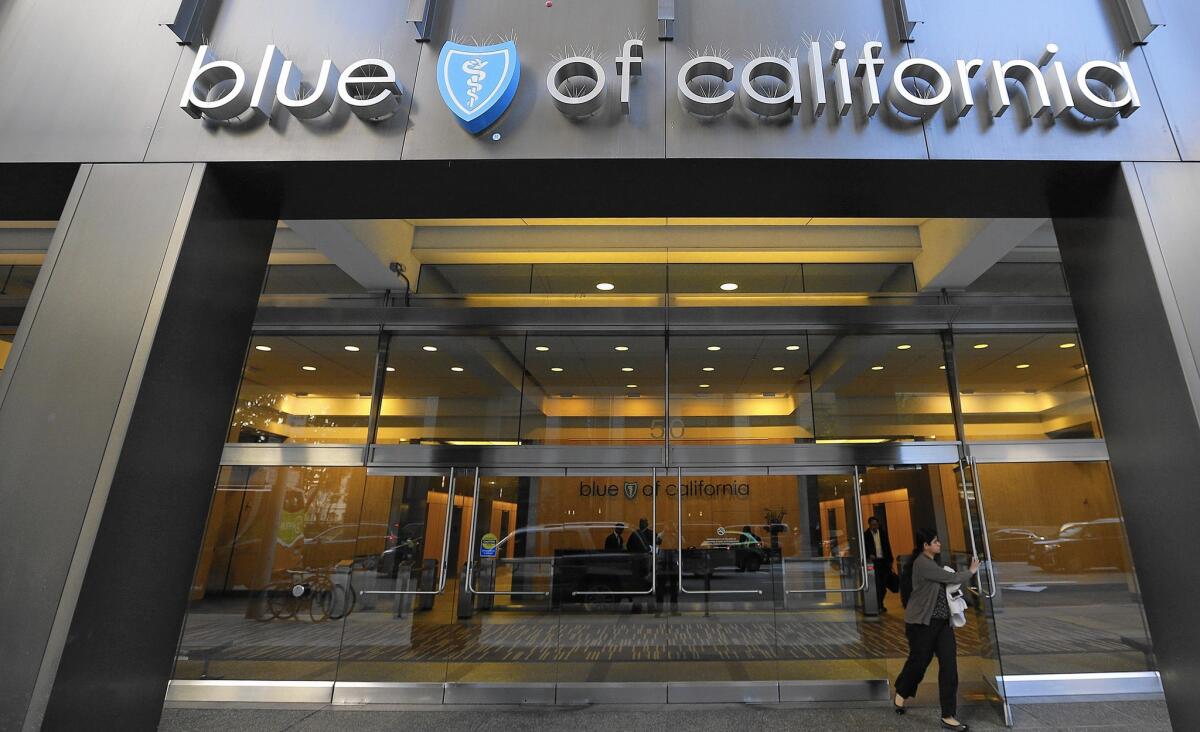Big hike in executive pay at nonprofit Blue Shield draws state scrutiny

Nonprofit insurer Blue Shield of California boosted executive compensation by $24 million in 2012 — a 64% jump over the previous year — according to a confidential state audit reviewed by The Times.
The health insurance giant won’t say who got the money or why. But Blue Shield’s former public policy director, Michael Johnson, who left this year and is now a company critic, said senior officials at the insurer told him that former Chief Executive Bruce Bodaken received about $20 million as part of his 2012 retirement package, on top of his annual pay.
Half a dozen other top executives also left the company near the end of 2012, which could have accounted for some of the spike in compensation. Some of this severance or retirement money may be paid out over time, extending beyond 2012.
The San Francisco insurer declined to confirm the total compensation for Bodaken, who was chairman and CEO from 2000 to 2012.
The audit’s tally of $61 million in pay for nearly 60 executives in 2012 appears to include Bodaken and others who left. But Blue Shield omitted their pay from a separate state filing that required 2012 compensation data on the company’s 10-highest paid employees.
The state requires companies like Blue Shield to submit information on annual pay, but the company interprets the rule to apply only to executives still employed at the time it files the paperwork — in this case, March 2013. Bodaken and other executives had left by then.
The revelations about the compensation — and the company’s assertion that it doesn’t have to disclose Bodaken’s full pay — come at a time when state officials are already scrutinizing the company’s nonprofit status.
“What is Blue Shield trying to hide? This raises so many red flags,” said Frank Glassner, chief executive of Veritas Executive Compensation Consultants in San Francisco. “Blue Shield owes policyholders an explanation for how it spent this money.”
California Insurance Commissioner Dave Jones said the company’s decision to exclude pay for Bodaken and other executives from its regulatory filing “raises very serious and troubling questions with regard to whether Blue Shield misled the Department of Insurance.”
“We will be investigating this discovery by the L.A. Times and looking at all of our options,” Jones said.
Blue Shield insists it has done nothing wrong and said that numerous factors led to the jump in 2012 compensation.
“We disclose executive compensation in full compliance with all regulatory requirements while at the same time respecting our employees’ privacy,” said company spokesman Steve Shivinsky.
“Many factors contributed to this one-time increase in officer compensation that affected a large number of employees, including severance, pension, deferred compensation, accrued vacation, merit increases, incentive pay, benefits and relocation expense reimbursement,” Shivinsky said.
Big windfalls for CEOs of nonprofit health insurers have sparked outrage elsewhere. Several years ago, the Massachusetts attorney general investigated the pay of nonprofit executives after disclosures at Blue Cross Blue Shield of Massachusetts.
The nonprofit health plan gave one former chief executive $16 million when he stepped down and paid $11 million to another CEO after he left in 2010. The insurer later agreed to refund some of the severance money to customers.
Bodaken, now 63, did not respond to multiple messages left by phone, email and through Blue Shield.
Bodaken received annual pay of $4.6 million prior to retirement. That figure is generally in line with what other chief executives at comparable nonprofit insurers have been paid.
During his tenure, Bodaken won praise for supporting universal health coverage at a time when the insurance industry opposed it. Later, he and the company were criticized for repeated rate hikes.
Publicly traded insurers report executive compensation in securities filings. Nonprofit insurers, if they are exempt from federal taxes, report pay data on 990 forms to the Internal Revenue Service.
Blue Shield doesn’t file a form 990, though. It has paid federal income taxes for years under a change Congress made in 1986 to treat large Blue Cross Blue Shield health plans the same as for-profit insurers.
Blue Shield is California’s third-largest health insurer with about 3.4 million members and $13.6 billion in annual revenue.
The company is trying to expand and get state regulatory approval for a $1.2-billion acquisition of a Medicaid insurer. Consumer advocates question the deal, arguing that Blue Shield could use that money to reduce premiums or improve care to underserved patients.
The revelation that Blue Shield’s compensation tab in 2012 grew sharply was contained in an audit by the California Franchise Tax Board.
In documents reviewed by The Times, auditors criticized the insurer for stockpiling “extraordinarily high surpluses” of $4 billion and for failing to offer more affordable coverage as a nonprofit. The Times reported in March that tax officials had revoked the company’s state tax exemption.
Blue Shield is appealing the tax decision, which is worth about $30 million annually to the company.
As part of the audit, records show, officials examined what Blue Shield reported on its state and federal tax returns as compensation for nearly 60 top officers, from vice presidents to the CEO.
Blue Shield paid $61 million to that group of executives in 2012, the most recent figure included in the audit. The company paid $37 million to its top officials the year before and $39 million in both 2009 and 2010.
The audit documents do not give a breakdown of how much went specifically to salaries, bonuses, severance pay or pensions.
In the end, the tax board did not cite Blue Shield’s compensation as a reason for revoking its tax exemption. But it left the door open to revisiting the matter, and the tax board is now considering Blue Shield’s appeal.
Both the insurer and tax board have refused to publicly release the audit and related records.
Blue Shield did not provide information about executive pay until it was required to do so by a 2010 state law.
The company still offers less information than other health insurers. It doesn’t put names with the data, for instance, or job titles beyond that of chief executive. Blue Shield also does not spell out what’s included in terms of salary, bonuses or other compensation.
For 2010, the insurer reported that its 10 highest-paid officials received $14 million in total.
The results were nearly identical for 2011. Then the numbers decreased to $10.6 million in Blue Shield’s insurance filing for 2012 — the one that omitted the pay of Bodaken and others. The company reported CEO compensation of $2.1 million, which it now confirms applied to its new CEO, Paul Markovich.
In its most recent filing, for 2013, the company said Markovich received $2.5 million and its top 10 officers collected $11.5 million.
Many of Blue Shield’s competitors are publicly traded industry giants that pay their CEOs more. Those companies are often bigger and also release more details on executive pay.
Anthem Inc., which sells Blue Cross coverage in California and 13 other states, paid CEO Joseph Swedish $13.5 million in salary and other compensation last year.
HMO giant Kaiser Permanente lists compensation for more than 70 executives in its federal 990 filings as a nonprofit, tax-exempt organization.
George Halvorson, Kaiser’s former chairman and CEO, made $10.2 million in 2013, the latest figures available. A Kaiser spokesman said that amount includes some of Halvorson’s retirement money. His successor, Bernard Tyson, received $4.3 million that same year.
Critics say it’s hard to judge Blue Shield’s compensation and make comparisons because the company has been so secretive.
“Blue Shield should be publicly reporting this information, in detail, like every other major health plan,” said Johnson, who resigned in March to mount a campaign calling on his former company to act more like a nonprofit. “There shouldn’t be any mystery.”
Twitter: @chadterhune







